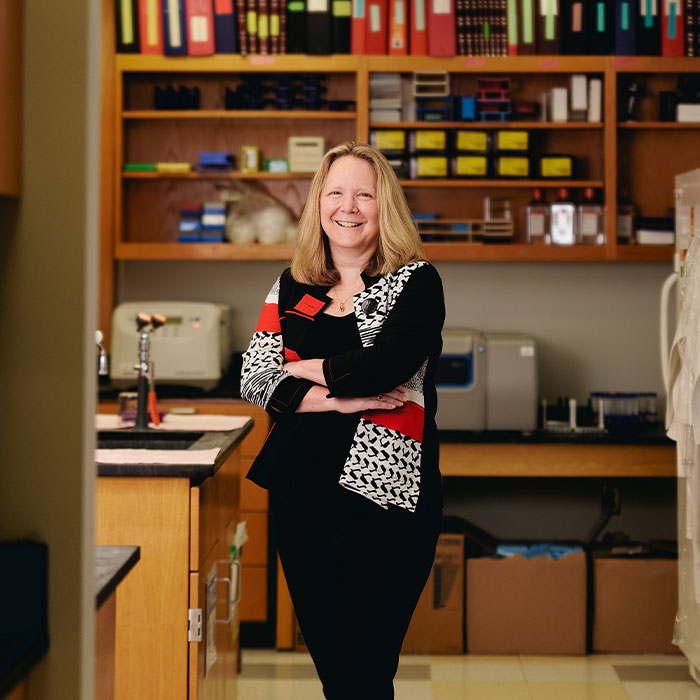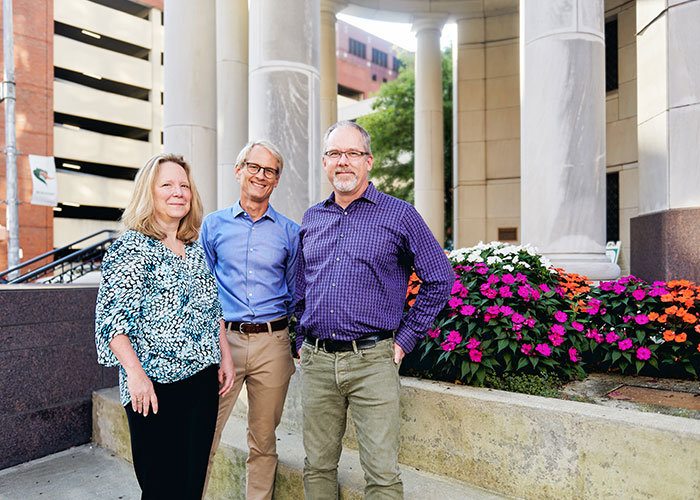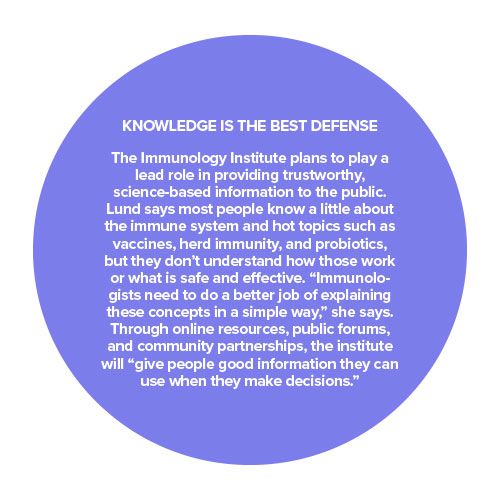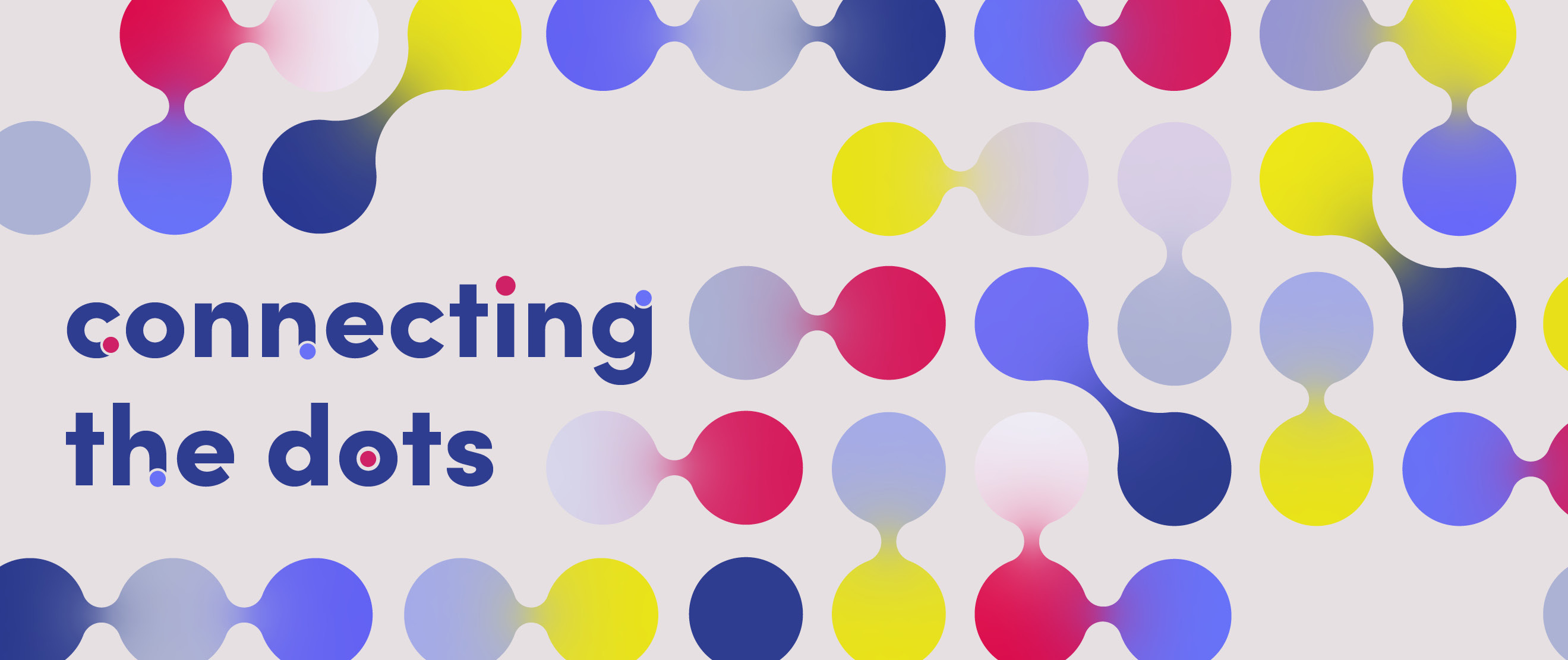When the COVID-19 pandemic erupted in early 2020, immunologists leapt into action. Here was a disease that looked familiar in many ways—a respiratory coronavirus like SARS and MERS, which they had studied for years. But they also were primed to investigate COVID’s more curious impacts on other parts of the body, as well as the lingering symptoms known as “long COVID,” because immunologists are literally everywhere in medicine.
They’re part of the teams studying infectious diseases, of course, but you’ll also find them alongside pulmonologists, cardiologists, gastroenterologists, oncologists, rheumatologists, neurologists, and many others. If the specialty concerns an organ or disease touched by the immune system—which is pretty much all of them—then an immunologist is involved.
UAB’s new Immunology Institute aims to connect all that expertise, linking more than 100 immunologists across the campus to answer a common question: How do you identify the treatment that works best for each patient, whether for COVID, cancer, or another disease? “We want to find biomarkers we can use to predict outcomes and select therapies that may be the most effective,” says Frances Lund, Ph.D., former Charles H. McCauley Chair of Microbiology, who serves as the institute’s founding director. The leadership team also includes associate directors Troy Randall, Ph.D., the Meyer Foundation William J. Koopman, M.D., Endowed Chair in Immunology and Rheumatology, and Paul Goepfert, M.D., the Edward W. Hook III, M.D., Endowed Professor in Infectious Diseases.  Fran Lund is the inaugural director of the UAB Immunology Institute
Fran Lund is the inaugural director of the UAB Immunology Institute
The institute, one of only a few nationwide, will provide the infrastructure to foster translational research, which will strengthen partnerships and an exchange of knowledge between basic and clinical scientists. For example, Lund explains that those clinical scientists will be able to use immunological assays in their trials so that they “understand not only how a therapy affects the end stage of a disease, but also how it works within the patient.” At the same time, basic scientists will be able to move their studies beyond animal models to people. “That jump is hard,” Lund says. “We can make those experiments possible by connecting them with clinical researchers who have access to samples and understand human disease.”
Lund highlights some current interdisciplinary research that represents the kinds of breakthroughs you can expect from the Immunology Institute:
Targeting Difficult Tumors
Lund is fascinated by the fact that scientists can teach the immune system to recognize and eliminate threats. Vaccines are one way to do that. Immunotherapies, which target cancer, are another—and pioneering UAB research is making them effective against tough-to-kill tumors.
In a first-of-its-kind phase 1 trial, Pediatrics professor Gregory Friedman, M.D., treated malignant pediatric gliomas in the brain with HSV-1 G207, a modified form of the herpes virus that causes cold sores. Once injected into the tumor, G207 replicates and kills cancer cells while triggering a strong immune response to the glioma. Eleven of the trial’s 12 patients responded to the treatment, with an overall survival rate that was more than double the median survival rate—less than six months—for children with progressive or recurrent high-grade gliomas. Some patients lived longer than 18 months.
“After treatment we saw a dramatic increase from few immune cells, or a ‘cold’ tumor environment, to numerous immune cells, or ‘hot,’ environment,” says Friedman, who also is a scientist in the O’Neal Comprehensive Cancer Center at UAB. “This is a critical step in the development of a safe, effective immunotherapy” for these pediatric gliomas, with less toxicity than chemotherapy and radiation.
A planned multi-institutional phase 2 trial could shed light on the optimal timing for treatment, as well as therapies that can be combined with G207 to magnify the anti-tumor immune response. Friedman’s team also is continuing another phase 1 trial to treat recurrent pediatric tumors like medulloblastoma that may have greater sensitivity to G207.
Meanwhile, Masakazu Kamata, Ph.D., an associate professor of Microbiology, is solving a different problem. Laboratory-produced monoclonal antibodies like rituximab have revolutionized cancer treatment by sticking to proteins on cancer cells, thus triggering the immune system to attack and kill the cells. But they don’t work well against tumors in the adult central nervous system (CNS) and lymph nodes simply because they are too large to move through the barriers protecting those organs. So Kamata and his team have shrouded rituximab in a thin polymer shell that includes connection points for cellular receptors, allowing it to slip past the blood-brain barrier and hitch a ride on immune cells to enter the lymph nodes. Studies in animal models revealed that a single cycle treatment increased rituximab levels in both areas, leading to “complete remission of all lymphomas including CNS-metastasized lymphomas,” Kamata says. Now the nanocapsules could open doors for monoclonal antibodies to treat other neuro-brain diseases, he adds. Left to right: Immunology Institute Director Fran Lund with associate directors Paul Goepfert and Troy Randall.
Left to right: Immunology Institute Director Fran Lund with associate directors Paul Goepfert and Troy Randall.
Protecting Preemies from Infection
The front lines of the body’s defenses run through the gut. That’s where most of the immune system comes face to face—or cell to cell—with an abundance of external pathogens. Yet in extremely premature infants, whose intestines are still developing after birth, invading bacteria can get the upper hand. Overgrowth of a species such as Klebsiella pneumoniae can spread into the babies’ bodies, raising the risk of life-threatening infections known as late-onset sepsis (LOS).
A UAB research team including Casey Weaver, M.D., and Michael Gray, Ph.D., found that these problematic bacteria share a common trait: “Unlike the bacteria that dominate a healthy microbiome, those that can cause LOS are able to use oxygen,” says Gray, an assistant professor of Microbiology. “Our results suggest that the amount of oxygen in the infant gut is an important factor in the development of LOS.”
Even more exciting, the investigators discovered that the presence of Lactobacillus murinus bacteria in the intestines seems to have a protective effect. In animal models, L. murinus dramatically reduced K. pneumoniae overgrowth when it was given before the LOS-triggering pathogen was introduced. Weaver, the Wyatt and Susan Haskell Endowed Professor for Medical Excellence in Pathology, says the result shows that “normal constituents of the microbiome in the neonatal gut are both necessary and sufficient” to help prevent LOS.
The discoveries could have implications for maternal and neonatal antibiotic use, which can impact protective bacteria in the infant microbiome. In addition, the National Institutes of Health recently awarded the team a grant to research the molecular mechanisms that enable those bacteria to prevent LOS. Identifying those could lead to the development of probiotics for human preemies. “The microbiome and its interactions with the immune system are complicated,” Gray says. “There’s a lot of work to do to figure out the detailed connections and causal relationships that would allow us to understand when probiotics would be the most effective treatments for specific diseases.”
Collecting Clues to Decipher COVID
In February 2020, Nathan Erdmann, M.D., Ph.D., marshaled a team to begin collecting COVID-19 samples from patients—even before the pandemic hit Alabama. “We recognized there was going to be a fair degree of chaos,” says Erdmann, assistant professor in the Division of Infectious Diseases. And in that situation, “one of the most valuable things for investigators is high-quality samples, particularly from patients with severe disease.” That preparation paid off: Not only was UAB ready to collect samples from its first COVID patient, but the team also could compare them with patient samples of typical seasonal coronavirus, providing an early understanding of immunological responses to the novel virus.
Today the Enterprise COVID biorepository includes blood, urine, saliva, and swabs from a cohort of nearly 4,000 patients, including 3,300 acute patients. Samples also represent deceased patients, vaccinated patients, and a control group. Altogether, the collection outlines a history of the pandemic in the region, which makes it unique, Erdmann says. “As things evolve, we’re able to reference the various phases of the illness and its strains as well as the native immune response to different treatment strategies.”
Collecting multiple samples from, in some cases, very sick patients in a hospital on lockdown was a challenge that no one person or lab could have accomplished, Erdmann says. Because hospital access was limited, he worked with clinical staff and UAB’s Institutional Review Board to obtain verbal consent from patients—and often found himself answering nurses’ questions at 2 a.m. The UAB Center for Clinical and Translational Science (CCTS) expanded the biorepository’s umbrella to include samples collected and processed by the Microbiology and Pathology departments.
More than 50 research teams representing myriad disciplines have worked with the biorepository to discover crucial details about COVID, says Jennifer Croker, Ph.D., CCTS senior administrative director and assistant professor of Medicine. Samples have helped investigators shed light on viral variants, testing methodologies, infection outcomes in immunosuppressed patients, and potential triggers for “long COVID,” for example. Others have demonstrated the role of early antibody responses in helping to prevent serious infection—and revealed that many infected patients don’t develop antibodies, emphasizing the importance of vaccination. Future research could provide clues to predict COVID severity and pave the way for new vaccines. – Charles Buchanan

